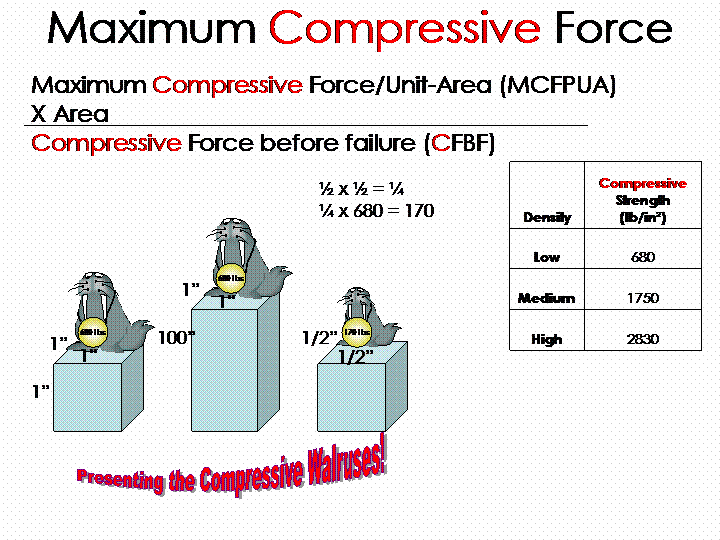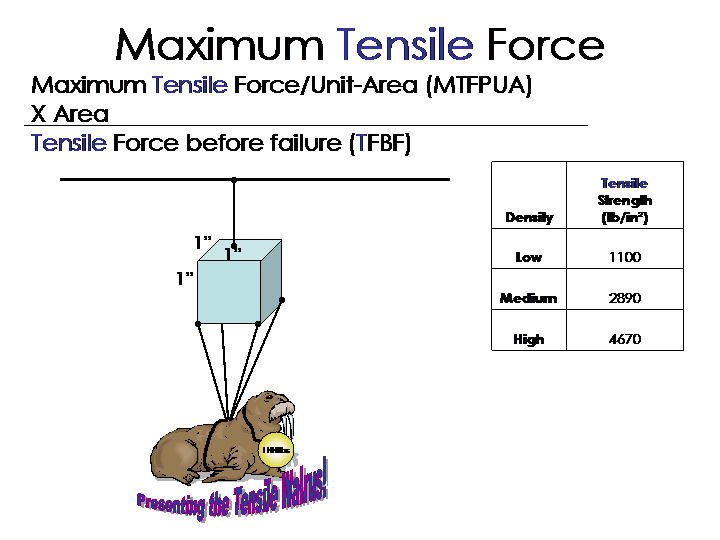|
"End Posts", "Top Chords",
"Vertical Hips"... All these pieces of a bridge are collectively
called "Bridge Members". There are three ways a bridge member
can fail. It can be crushed, it can be torn apart or it can
buckle. This page talks about the first two, and of those, talks
about crushing first.
Maximum Compressive Force
Suppose you took a 1" x 1" x 1"
cube of balsa wood, put a pressure plate on top of it and then put on
successively heavier weights. At some point, the walls of the
internal cells of the balsa wood would collapse and the cube would be
crushed. If you recorded the total weight as you did
this experiment, you would find that there was a borderline weight.
If you stayed on the light side of the borderline, the cube would be
fine. If you crossed over to the heavier side of this
borderline, the cube would be crushed. This borderline is called
the balsa wood's maximum compressive strength, and the force is called
the maximum compressive force.

You would find that this
borderline changed based on how dense the balsa wood was. If it
was low density, the border line would be around
680 pounds. If it was medium density, the borderline
would be around 1,750 pounds. If it was high density, the
borderline would be around 2,830 pounds.
Intuitively, this seems a little
bit weird. Clearly, if you tried to balance a 680 pound walrus
on the top of a 1" x 1" x 100" piece of balsa wood, it would "snap".
(the balsa wood, not the walrus. The walrus would go "plop").
But that kind of failure is called
"buckling", not
compressive failure. Here we assume the piece of wood is so
short that no buckling occurs.
"Compressive Force Before
Failure" scales with surface area. If we put weights on a 1/2" x
1/2" x 1" piece of balsa wood, it would hold 1/2 x 1/2 or 1/4 as much
weight. So a 1" x 1" piece of wood that could hold a 680 pound
walrus would now only hold a 170 pound walrus (170 = 680/4) if we cut
away 3/4 of it.
So, what possible use is this?
Well, recall from our internal force analysis that if we put 50 pounds
on each corner, that results in a force of
78.11
pounds on the "End Post". So, for every 78.11 pounds of load on
the "End Post" we have 200 pounds we can put on the bridge (4 corners
x 50 pounds). Stated differently, for every pound of load on the
"End Post" load, we can support 200/78.11 = 2.56 pounds of load.
Since the "End Post" cross
section is 1/2 x 1/2 or 1/4 inches squared, then if it was made of
light balsa wood, it could tolerate at most a 170 pound load passing
through it. Or, 170 x 2.56 = 435 pounds on top. Now, here's the
important part. This is more weight than Katherine's bridge held, even
though she used heavy balsa wood for the "End Post". Heavy balsa
wood is 4 times as strong as light balsa wood and so the bridge could
have held over 1,700 pounds if "End Post" compressive failure was
the bridge's weak point. Clearly it wasn't. (In the
buckling section, we
will discover
that if Katherine had known about algebra, trig, Maximum Compressive
Force and buckling, she could have made her "End Post" a little
lighter and used the weight savings to put in more cross bracing.
She didn't, but now you do!)
Maximum Tensile Force
As balsa wood can be crushed, it
can also be torn. The equations for tearing balsa wood are
similar to those for crushing balsa wood and depends on force per unit
area. In particular, suppose we had another hapless walrus,
weighing 1,100 pounds, suspended from a rope connected to a 1" x 1" x
1" piece of low density balsa wood. He would be fine until he
ate anything, and then he would cross the "Tensile Force before
Failure" borderline and the balsa wood would tear apart.

Relationship between compressive and tensile strength
The table below uses the
compressive an tensile strengths listed
here and divides one by the other for each density of balsa
wood.
Balsa Wood Tensile/Compressive Strength Ratios
|
Density
|
Compressive Strength (lb/inČ)
|
Tensile Strength (lb/inČ)
|
Tensile/Compressive Strength Ratio
|
|
Low
|
680
|
1100
|
1.617647
|
|
Medium
|
1750
|
2890
|
1.651429
|
|
High
|
2830
|
4670
|
1.650177
|
Clearly, balsa wood is 60%
stronger under tension than under compression for all densities.
So, what possible use is this?
Well, recall that the compressive and tensile forces in the top and
bottom chords are equal (each
are 60 pounds), as are their cross sectional areas (about 7/32
square inches for each chord and 2 x 7/32 = 14/32 for the left and
right chords together). Let's compute the failure points for two cases,
one where the lighter material is on the top, the other where it is on
the bottom.
|
Chord
|
Case 1:
Force needed to fail with low density on top chord,
medium density on bottom
|
Case 2:
Force needed to fail with medium density on top chord, low density on bottom
|
|
top
|
14/32 * 680
<- weak point
|
14/32 * 1,750
|
|
bottom
|
14/32 * 2,890
|
14/32 * 1,100
<- weak point
|
Clearly, this supports
Katherine's "rule of thumb" of using lighter wood for the
"Bottom Chord" (which is under tension) and heavier wood for the "Top
Chord" (which is under compression) since it is better to have the
bridge tear at 14/32 * 1,100 pounds than be crushed at 14/32 * 680 pounds.
Summary
We can get two engineering
rules from this analysis.
-
Even light grades of balsa can
can support a lot of weight without failing under tension and
compression. So think carefully about using heavier grades of
wood.
-
Balsa is stronger under tension
than compression. So, it makes sense to put lighter wood on
tension members and heavier wood on compression members if the cross
sections have equal area.
|